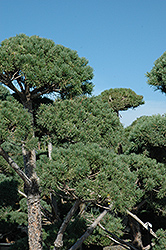Plant Library
Poodle Dwarf Scotch Pine
Pinus sylvestris 'Poodle'
Height: 5 feet
Spread: 4 feet
Sunlight:
![]()
Hardiness Zone: 3a
Other Names: Scots Pine
Description:
An ornamental dwarf variation of scotch pine with interesting clumped needle growth; this tree must be kept pruned to maintain the poodle-puff effect but is well worth it for the exotic element it will add to your garden
Ornamental Features
Poodle Dwarf Scotch Pine is a dwarf conifer which is primarily valued in the landscape or garden for its ornamental upright and spreading habit of growth. It has attractive grayish green evergreen foliage. The needles are highly ornamental and remain grayish green throughout the winter.
Landscape Attributes
Poodle Dwarf Scotch Pine is a dense multi-stemmed evergreen shrub with an upright spreading habit of growth. Its relatively fine texture sets it apart from other landscape plants with less refined foliage.
This is a high maintenance shrub that will require regular care and upkeep. When pruning is necessary, it is recommended to only trim back the new growth of the current season, other than to remove any dieback. Deer don't particularly care for this plant and will usually leave it alone in favor of tastier treats. It has no significant negative characteristics.
Poodle Dwarf Scotch Pine is recommended for the following landscape applications;
- Accent
- General Garden Use
Planting & Growing
Poodle Dwarf Scotch Pine will grow to be about 5 feet tall at maturity, with a spread of 4 feet. It tends to be a little leggy, with a typical clearance of 2 feet from the ground, and is suitable for planting under power lines. It grows at a slow rate, and under ideal conditions can be expected to live for 40 years or more.
This shrub should only be grown in full sunlight. It prefers dry to average moisture levels with very well-drained soil, and will often die in standing water. It is considered to be drought-tolerant, and thus makes an ideal choice for xeriscaping or the moisture-conserving landscape. It is not particular as to soil type or pH. It is highly tolerant of urban pollution and will even thrive in inner city environments. This is a selected variety of a species not originally from North America.


